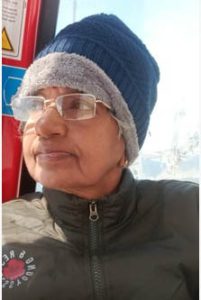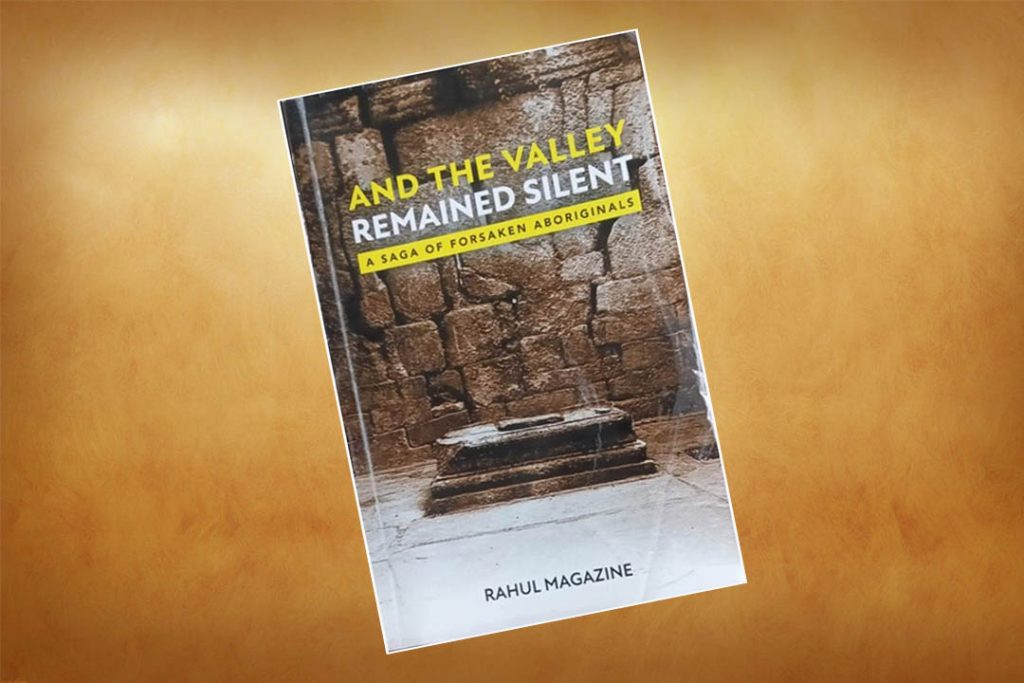Any kind of injustice done to others makes us feel restless. Any kind of violence done on others makes us feel stifled. Any kind of threat to life given on to innocent people makes us furious. But what will be our condition if we hear the story of a biased act culminating in wreckless shooting, killing and bloodshed ? No doubt it will make us feel tongue-tied and numb. However, this was the same predicament in which the Kashmiri Hindu aboriginals had been caught before their exodus from their much beloved motherland Kashmir. The book ‘And the Valley Remained Silent’ is the agonising account of the same horrible and spine chilling narrative of the Kashmiri Hindus written by Dr. Rahul Magazine, presently serving K.M.C. Hospital at Manipal (Udupi) as a doctor. Since he himself is the second generation member of a family affected, we may fully trust it as authentic.
The 266 pages of the book are stained with human blood and tears all through, making the readers’ heart bleed. The fact that the Muslim fanatics and fundamentalists of the valley had incessantly given physical and mental torture to the Hindu aboriginals of the land in the name of protecting their religion makes our blood boil. Of course, the terrorists originated in Pakistan with a slogan that they are Jihadis, fighting to safeguard their religion. They trespassed and came to Kashmir also to take the Kashmiri Muslims to their fold. Their intention was to eliminate and expel the minority Hindus from Kashmir and make it a part of Pakistan. That is why they instilled this idea among the Kashmiri Muslim population, threatened the youths to join their gang and assist them drive away the Hindus from Kashmir.
All these did not happen all of a sudden. The preparations to wipe out the Hindus had started with a neat plan around 1986 itself. In the beginning, threatening, attacking, gun-shooting and bomb explosion in public places used to be very rare. But as the years rolled on, the Jihadis became more and more aggressive, always hunting for their victims. Besides the Jihadis, there were the Azadi fighters too, who demanded the separation of Kashmir from India. Very often, there used to be processions holding placards and crying of slogans against India. The Muslims of the valley were under the impression that there are only Hindus living in India, whom they did not want. They hated the Kashmiri Hindus assuming that they supported India. Thus, Kashmir had become a hub of anti-India activities and communal frenzy torturing, looting, bamboozling, sabotage and shooting the Hindus as and when they liked. On the whole, they were trying to obliterate the Hindu community living in Kashmir. The only option they gave was either to convert to Islam or run away to Jammu or other parts of India. Their atrocities reached their height in January 1990 when there was a mass exodus of lakhs and lakhs of Hindus who left the valley unable to bear with their hooliganism. The threat to their lives given by the Pakistani terrorists and the locals trained under them, made them flee despite cherishing a strong desire in the heart of their hearts to remain in their homeland. It all happened just because of the amoks spewing venom on them, their blind dedication to their religion and their stark ignorance of the fact that they hated a community which openheartedly loved the people of all other religions. They felt overjoyed when their brethren left the place and they immediately grabbed hold of their houses and landed properties.
Now it is more than three decades after the dismal event took place. The author of this book has written it with a particular purpose. It is not just for recording the memories of those days. As a doctor, when he got chances to visit different parts of India, the Kashmiris whom he met there told him that the usurpers of their properties in Kashmir must be feeling guilty of the sins they have committed and that is why they are trying to cover themselves behind the stories fabricated by themselves that none of them had forced the Hindus to leave, but they ran away out of fear. The terrorists had given a threat just to instill fear in them so that they would not obstruct their plans. Once when the author went for a conference at Kochi, two Muslim youths whom he met near a synagogue , without any hesitation told him that nothing would have happened to those run away Hindus if they had stood firm. This made the author seriously think that the actual truth might be buried in history and only the concocted stories will last forever. This realization made him decides to write a book on all the bloody incidents as a documentary and pass it on to the future generation.
Dr. Rahul very systematically begins his narrative with the details of the early historical glory of Kashmir – its scenic beauty, its beautiful temples, its cool weather, its peaceful life under the successful rules of Kings like Kanishka, Lalithaditya, Avanthivarman , Jayasimha and the like. But gradually with the invasion of the Mohammedans from Turkistan and Iran, the life of the Hindus was in peril. They not only tormented them physically but plundered and tore down their temples which were a part and parcel of their life. After the Mohammedans, the Mughals came and they also did the same. During Aurangajeb’s rule, the persecution and forced conversion of Hindus were resumed. After his death, the Afghans invaded the valley and took it into their possession. Under them, the Hindus were petrified. Then Maharaja Ranjith Singh defeated the Afghans and the Sikh rule continued till the advent of the British. Then Ranbir Singh, the Dogra ruler of Jammu, defeated the British and took Kashmir into his possession. During the Dogra rule, India’s struggle for independence started. Then Hari Singh, the last Dogra king, had some clash with Jawaharlal Nehru. So, when India got freedom, Hari Singh thought of separating Kashmir as an independent kingdom. When Pakistan noticed him off-guard, it immediately let loose a large set of tribal raiders to attack Hari Singh’s army. At this time, the Muslim troops of his army turned traitors and deserted him. As a result, Hari Singh had to accept defeat. The tribal raiders indulged in large scaleloot, rape and killing, targeting only the Hindus and Sikhs. This made the Dogra King send a request to the government of India for help. The Indian troops landed at Srinagar after he signed the Instrument of Accession to the Indian Union. The raiders were pushed back by the Indian army and a large part of Jammu and Kashmir was liberated. Gradually, the Dogra king was ignored by Nehru and after passing civil codes 35 A and 370, the power of ruling was given to Nehru’s friend Sheik Mohammed Abdulla.
Dr. Rahul begins to speak about the afflictions suffered by the beleaguered Hindus from this point onwards. After its accession to the Indian Union, the Muslim political leaders became relentless, exercising their power wherever they liked. When the Land Reforms Act was passed, its primary beneficiaries were the Muslims. And the Hindus were deprived of their lands which they had inherited from their ancestors. In fact, the Muslims, large in number, were very poor till then, almost on the verge of begging. But, now, their economic prosperity flourished to such an extent that their status in the society rose very high.
When terrorism broke out in the valley, the politicians of both Kashmir and outside, propagated the news that the Muslim youth had revolted due to the abject poverty and hardships they faced in the valley. The author says that it is far from truth. The politicians incriminated the Kashmiri Hindus for dominating and exploiting the Muslims after Independence. It is really laughable to think of such a small minority exploiting such a big majority.
From the lowest chaprasi to the chief minister, all positions had been occupied by the Muslims. The Hindus were replaced in government jobs under a well thought our plan. In the name of Jihad there was a gradual criminal neglect of the minority and its culture. Year after year the Hindus were pushed aside to such an extent that the public celebration of their religious festivals also was banned by the government. The bigotry of the Muslims grew up in such a way that they openly asked “Are you a Muslim or a Hindu?”. Even the small school children were not an exception. The author had his primary and secondary education in such a disheartening atmosphere.
Education and employment Sectors were completely in their hands and they deliberately denied opportunities of higher education and government jobs to the Hindus, despite their performance being far better than the others. The gives several such instances where the Hindu youths were thwarted primarily viewing their religion.
The mass exodus of the Hindus took place in 1990. But the prelude to it had been written around 1984 itself. Day by day violence and vandalism went on increasing with added strength and vigour. The terrorists who came from Pakistan, threatened every Muslim household, pointing their gun that their children should join their gang. If they protested, the youths were forcibly taken. If they found any Hindu speaking against their Azadi movement, they were shot on the spot. The author says that Kashmir had become another Nazi Germany.
The author’s father was a professor of Engineering in REC Shrinagar. He and many of his friends used to advise the youth to concentrate on their studies instead of joining the sinister terrorists. Therefore, all of them were in the terrorists’ hit list. The terrorists played the trick in such a treacherous way that they took the local Muslims to their good books and instructed them to act friendly with the Hindus for catching hold of them easily. Every other day there used to be strikes, riots, traffic block, bomb blasts and curfews everywhere. The Hindus, who strongly believed that their children’s higher education was the only way out, found it a Herculean task to send their children to school. The author quotes several instances where unpredictable situations used to be there even on the day of important public examinations. Those who went out from their houses to buy groceries, or purchase some items of urgent need, were not sure of returning home safely. Many Hindus were shot dead in public with no one to take care of their bodies lying in a pool of blood.
When the situation was worsening like this, the Govt. of India appointed Jagamohan as the governor of Jammu-Kashmir. CRPF also was sent to take care of the situation. But the violence did not subside because the terrorists and their accomplices started doing their underworld activities behind the screen. Ethnic cleansing was their main agenda. According to them the Hindus were the ‘supporters of India and Mukhbirs (informers). Hence they did not have any right to remain in Kashmir, they blurted. They sent anonymous threatening letters to them saying that if they continued to live there any more, they would lose their lives. They had only one choice-either convert to Islam or run away to Jammu. On 19th January 1990, the genocide reached its pinnacle. The terrorists had taken the mosques also to their possession, from where they announced on loudspeakers in an intimidating tone that the life of the Hindus was at peril. There was no other alternative left for lakhs and lakhs of Hindus but leave their dear homeland, where they had been born and brought up in houses built thousands of years ago by their ancestors. They had to leave in a hurry, without taking their important precious belongings. Besides, they did not have any good facilities in Jammu to live there with their families and they had start afresh facing a lot of inconveniences. Though they wanted to go back to their former abode, they could not do it because within no time their houses and lands had been illegally occupied by their neighbours, who used to be very friendly and affectionate with them earlier. A few of them came forward to buy their properties at a throwaway price.
The author feels deeply disturbed when some genuine questions rise in his mind: ‘Is all the talk about equality of men meaningless? If one’s faith determines one’s fate, why this empty talk of equality?
After leaving the valley, the Hindus, with penury from head to foot, had literally become refugees. But the Kashmiri politicians euphemistically called them ‘migrants’. The author points out that the same people had called the heartless terrorists ‘militants’ to minimize the effect of their harsh deeds. However, the spiritual power of the Hindus did not allow them to accept defeat. They knew that Kashmir was the abode of Goddess Sharada, and they believed that education is the only means of coming up in life. That is why they struggled hard to give good education to their children without discriminating between boys and girls. As good luck would have it, their dreams came true when their children fared well, came up with flying colors in higher education and were placed in lucrative jobs. Now they are happily settled in different parts of India. But the memories of their traumatic experiences three decades ago and their inability to go back to their native place has made them feel terribly forlorn, says the author.
While expressing his sorrow about the back-stabbing of many of the Kashmiri Muslims, the author does not forget to pay his tributes to some of the broad-hearted Muslims with very liberal views. His childhood friend Yusuf is a well read knowledgeable person. His mother had treated the author like her own son. She had great fear that her son might be forced to join the terrorists’ gang. The author’s father also had good friends. They believed in communal harmony.
“There is no doubt that the majority of the Muslims did not actively participate in killings and rape. But they did not raise their voice against terrorism” says the author. (P.260). Their silence indirectly helped the terrorists to carry on with their brutal and barbarous deeds. Hence, silence also is harmful, says the author. That is why he has given the title “And the valley remained silent”. Today also the same silence remains there and that has led to the recent massacre at Pehalgam. Had the entire Kashmiri population vociferously raised their voice in the beginning itself, the valley would have remained safe today.
Dr. Rahul has neatly presented the entire story of the sufferings of the Hindu aboriginals of Kashmir valley under the tyranny of the terrorists. He is very careful in choosing appropriate words to describe the delicate situation in an objective style as he himself says that his purpose is to make a document of the sad events ungrudgingly for future reference.

Dr. Parvathi G. Aithal
Dr. Parvathi G. Aithal is a retired Professor of English from Bhandarkars College Kundapura. Born and brought up in a village called Dharmathadka near Jumble, she had her education at Kasaragod Govt. College and Manasa Gangothri Mysore. She received her doctorate degree from Kannur University Kerala.
She is a famous writer, writing in five languages-Kannada, English, Hindi, Malayalam and Thulu. So far she has published more than 100 books. She has received several prestigious awards from the govt. of Karnataka as well as private organisations. She has worked as a member of the jury six times to decide Central Sahitya Akademi translation awards.

